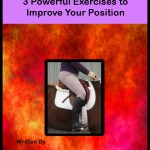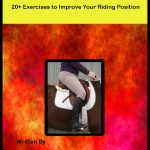Why do I need to Ride Circles?

![]() photo credit: marcuskillin
photo credit: marcuskillin
Just as you and I are left handed or right handed (I’m left handed by the way) your horse is more supple one direction than the other. Riding circles, turns, and changes of rein will help get and keep the horse supple so he is equally supple on each rein.
Lateral suppleness developed through the correct riding of circles will help strengthen and balance the horse for higher level movements. When working on a circle the horse should be bent from poll to tail in the same bend. If your horse is not bending properly he will:
- Pop his shoulder – if you horse pops his shoulder it can be seen and felt as a concaving (hollowing) of the inside of the horses neck and felt almost as a drifting out of the shoulder toward the wall. This is very apparent when riding on the open part of a circle; that is the part of a circle that is not made up of the wall of an arena. A popped shoulder is usually a result of the rider not riding the horse from the inside leg to outside hand or not enough supporting rein.
- Drop his shoulder – a dropped shoulder is the shoulder not being supported by the riders inside leg. If watching this horse it will ‘load’ its shoulder and the inside front leg will travel to the inside of the circle. Most riders try to fix this by using an indirect rein to lift up the horse. Although it will momentarily help the horse must learn to balance itself from the riders inside leg to the supporting outside rein. Once the horse is into the outside rein this evasion usually disappears.
- Swing his hind quarters – swinging the quarters out on the circle is a common evasion and can be corrected by using the outside leg behind the girth to keep the horse round. This is a common evasion because the horse will take the path of least resistance and swinging the quarters out is the easiest way to get out of bending and engaging the hindquarters.
- Drop his hind quarters – if the horse is stronger to one side the quarters may swing in to compensate. To prevent this from happening keep your inside leg active at the girth.
To help get and keep the correct bend:
Get help from a coach or instructor who can see if your horse is bending properly.
Ask a friend to video you while you ride. From the tape concentrate on where the horses body and legs are. If his hind hooves step into the prints of his front hooves you’re safe. If his hind hooves step on the outside of the circle that his front hooves make you will have to decide if a) he is swinging quarters out or b)dropping shoulders in.
If his hind hooves step into the inside of where his front hooves are you will have to decide if he is a) popping the shoulder or b) dropping his quarters to the inside.
Spiral into a smaller circle and then back out again. This will help develop bend and control over your horse.
Ride changes of rein. Be aware that you should never ride around the arena or schooling area more than once without performing a circle, change of rein or transition. It also prevents the horse from getting bored (no pun intended).
 Try these three powerful exercises to get strengthen your position.
Try these three powerful exercises to get strengthen your position.

How funny – I tend to focus almost exclusively on circles, figure-eights and cerpentines when in an arena (probably to a fault). Your idea of video taping is a great one. You can even do this with a tripod if a human isn’t handy. It’s amazing how much you can learn about what you’re doing (or not) by seeing it on film. There is a lot of truth the the ‘picture’s worth a thousand words’ mantra.
Thanks Nanette, I think we do somehow get into a rut and perform the same movements over and over again. It is best to push yourself and be confident that we can move beyond the 20m circle.
I agree that riding circles and doing lateral work – correctly – are an important part of training a balanced horse. What many show riders forget (in all disciplines) is the importance of allowing the horse to go forward and stretch as part of the training program. Lengthening and stretching should be included throughout the ride not just as the beginning and end. Even better – go for a ride outside the ring/arena every once in a while. Even walking around a paddock or hayfield makes a nice change and provides an opportunity to work on ground that is not perfectly flat.
I agree with you Anne. Forward is key.
As a coach and horse show judge I certainly see the benefits of riders hacking out and riding beyond the confines of the areana. Just this past week a friend of mine was astounded that I would have allowed a horse that was shown in the hunter ring to school over natural jumps! In addition to a change of scenery it keeps the horse interested in the job at hand…. and it is fun to boot!